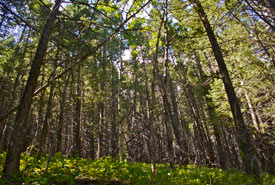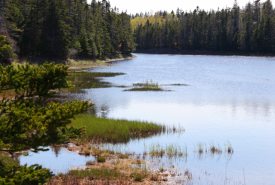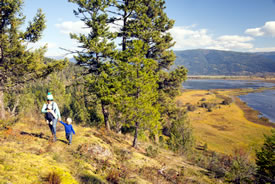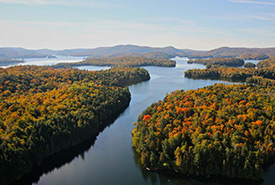Conserving Canada's natural capital

Lusicich, Crowsnest Pass, AB (Photo by NCC)
It might be hard to imagine that there's a close connection between my job as an economist at TD and my passion for the great outdoors — camping, hiking and canoeing being among my favourite pursuits. But there is. Over the past two years, the concept of "natural capital" occupied much of my time, leading me to draft papers not just on the subject itself but that examine the natural capital value of urban forests in Toronto and other cities across Canada.
Natural capital — in other words the financial value provided by natural resources and ecosystems — helps us to consider all of the positive impacts that our protected areas and other natural endowments give us, including benefits that are diffuse (i.e., that don't specifically go to a particular person or group) or that don't have a market price (what economists call externalities).

Salmonier River, Avalon Peninsula, NL (Photo by Mike Dembeck)
Thinking about Canada's wilderness areas through the lens of natural capital makes the economic case for their protection crystal clear. When we think about all of the benefits these lands provide, like clean air and water, species habitat, biodiversity preservation, and countless others, we intuitively recognize that the value of these spaces is more than just the price of the land, or the potential financial gain from the harvesting of timber or other resources. By putting a value on them we can start to make better, smarter decisions that incorporate all the services that these spaces provide.
The importance of the work the Nature Conservancy of Canada (NCC) has been doing for more than 50 years becomes startlingly clear when viewed through the natural capital lens. To illustrate the point, Dan Kraus, a conservation scientist and senior director of conservation program development at NCC, and I undertook a natural capital valuation of three properties that were recently acquired by NCC with support from the TD Forests program. The properties we examined are broadly representative of the 21 Canadian properties associated with the TD Forests program but at the same time have their own unique characteristics.

Midgeley, BC (Photo by Steve Ogle)
The Midgeley property lies at the southern end of B.C.'s Kootenay Lake and includes wetlands that have been recognized both as wetlands of importance and as an Important Bird Area (IBA). The property supports a multitude of rare species and is part of an important linkage area for local grizzly bear populations.
The Lusicich property, in southwest Alberta, boasts a mix of fir and aspen forests as well as grasslands and pasture. The property provides important connectivity for a number of species, including grizzly bear, elk and grey wolf.

Kenauk, QC (Photo by Kenauk Nature)
Farther east is the third property we looked at — Kenauk, which lies north of the Ottawa River in Quebec. A sizeable property (9,990 acres/4,042 hectares), it boasts deciduous forests interspersed with smaller stands of birch and aspen, as well as lakes, wetlands and rock barrens. More than 30 rare species have been documented on the Kenauk property.
With such rich, varied vegetation and land types, it is not surprising that the value of the natural capital services provided by these properties is quite high — more than $86 million per year (taking the value of past stored carbon into account). By helping remove harmful pollutants from both the air and water, these properties provide valuable services that benefit nearby communities and society at large. I should point out that the valuation is very conservative, for it includes only the atmospheric and water effects provided by the properties. Other important services provided by the properties, such as biodiversity preservation, habitat and of course cultural values, means that the true benefit — and economic value associated with those benefits — is higher still.
What this natural capital valuation provides is in many ways a confirmation of what most of us have likely felt all along: that important habitats and wild areas have a value that far exceeds the selling price of the land and that protecting these areas means that not only we, but also generations to come, will be able to realize the important stream of benefits they provide.


